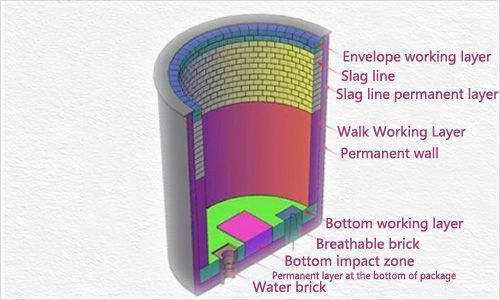
First, the ladle refractory is used to transport high temperature molten steel. During the transportation process, high temperature molten steel and molten slag around 1680 ℃ scouring and eroding it, especially in the slag line area, and the erosion erosion is more serious, which is an important factor determining the service life of a tank.
Second, the refining treatment outside the furnace such as LF is serious for the destruction of unburned fire bricks.
Third, the refractory lining is subjected to severe temperature changes during tapping and outflow of molten steel, and thereby causes cracking and flaking of the lining refractory material.
Fourth, when the refractory ladle is loaded into the molten steel in the converter, the high temperature molten steel has a strong mechanical scouring on the bottom, so that the lining refractory material at the part is prone to damage due to thermal shock.
The damage mechanism of ladle refractories is mainly caused by high temperature slag erosion and penetration. The ladle slag line is mainly melted, and the side wall portion is cracked and thermally peeled off due to the penetration of the slag. The rate of melt loss is related to the slag temperature, viscosity, and the rate of reaction of the refractory material. The high temperature of the molten steel, the long residence time in the bag, the low viscosity of the slag, the pore penetration of the matrix material, the liquid phase penetration and the diffusion in the solid phase cause a qualitative change in the composition and structure of the material surface to form a dissolution. A higher degree of metamorphic layer is prone to spalling and accelerates the damage of the lining refractory brick.
The lining of refractory materials with the same chemical composition or different varieties has different damage speeds due to their different structures and properties. The refractory ladle can not be operated continuously, so that the temperature of the refractory lining is reduced or even cold packed, and the refractory lining structure peeling off is easy to occur, and the service life of the ladle is reduced.
The erosion of the refractory material by the slag is not limited to the dissolution of the surface, and the slag can infiltrate the inside of the refractory material, enlarge the reaction area and depth, and change its composition and structure near the surface of the refractory material to form a highly soluble metamorphism. Layer, accelerated damage, the proportion of such intrusion is roughly proportional to the porosity. Therefore, even if the chemical composition of the refractory material is the same, the melting loss rate is significantly different due to its different structural structure.
The higher the open porosity of the refractory material, the faster the slag intrusion rate, and the intrusion ratio is approximately proportional to the porosity. Even if the fireproof refractory material has the same apparent porosity, the shape, size, and distribution of the pores are different, and the erosion rate changes.
Refractory Ladle Lining Feature
1. Dense and uniform structure.
2. High temperature micro-expansion.
3. Good volume stability; high strength.
4. Low ratio of medium temperature strength to high temperature strength.
Refractory Ladle Lining Man- Made Causes
1.Improper selection and mismatch off fireproof refractory materials.
2.Improper use of refractory materials, such as masonry methods and unreasonable baking methods.
3.The ladle turnover period is too long to cause cold pack.
4.Improper unpacking, damage to the permanent layer of the ladle.
5.Failure to take timely repair measures.
Refractory Ladle Lining Solution
1. Improving the slag resistance of refractory materials.
2. Reducing the porosity of the refractory material and reducing the erosion passage of the slag.
3. The slag reacts with the refractory material to form a high melting point compound retaining wall to prevent the slag from penetrating.
4. Increase the viscosity of the slag. The greater the viscosity of the slag, the less aggressive it is to the refractory.
5. Understand the performance of the refractory materials used, rationally determine the conditions for use of the ladle.
6. Accelerate the use cycle of ladle as much as possible to achieve "red envelope" work.
7. The damaged part of the lining refractory material should be sprayed or replaced in time.


